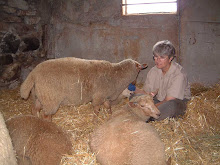I was reorganizing my recipe books (and updating my new recipe page on our website) and I started to read through some of my old recipe books. I was reading a 1950 edition of the Fannie Farmer's Boston Cooking School Cook Book. It was very interesting to see what they had to say about beef and chicken. Here are a few quotes.
"The quality of beef depends on the age of the animal and its feeding. The best beef is from a steer 4 to 5 years old."
and Chicken:
"Broilers or spring chickens or squab chickens are young, tender birds (8-14 weeks old). Allow 1/2 small broiler to a person.
Fryers weigh 2 1/2 to 3 1/2 pound (14-20 weeks old). One fryer serves 2 to 4.
Roasters weigh 3 1/2 pounds and over (5-9 months). A 4 pound bird serves 4 to 6.
Capon (unsexed male) usually weigh 7 to 8 pounds and serve 8 generously."
Oh have times changed. Most beef is processed between 12-20 months of age. And with current chicken breeds it is easily possible to have a 9 week old bird dress out at an average of 6 lbs. I have done that myself numerous times. It brings up what we have gained and what we have lost.
I think that one thing we have lost is flavor. A beef animal takes time to develop the marbling throughout the meat and as I mentioned in an earlier post, most of the flavor is in the fat. The gains are obviously quicker turnaround times and reduced feed costs... maybe. To bring an animal to market faster required more concentrated feeds -- grains, higher protein concentrates etc. These feeds cost more than a forage based diet. You can go back and forth on the cost, time argument and much of that depends on location, market etc. A pasture based diet is only inexpensive on cheap farm land. Land prices around much of southwestern Ontario could make a pasture based system very expensive indeed. What it should come down to is what the client wants in their meat and what they are willing to pay for it. We will always be a pasture based management system supplemented with grains to start and then finish the animals. We will process at 2 years of age at the earliest. However we are small enough to allow us the flexibility of breaking from the norm. We will play with our management to make the best flavor and quality in the beef.
Another unexpected loss is quality of leather. A number of years ago, I apprenticed with a harness maker. He bemoaned the fact that it was getting increasingly difficult to get good quality leather. And the reason is that cattle are slaughtered much younger. The hide thickens as the animal ages. (You sure notice this come vaccination time.) Younger animals means thinner hides.
As I mentioned I can raise a roaster sized chicken in 9 weeks. However to do so we give them free access to high protein feed. This year we will reduce the protein level in the feed, and allow them access to pasture. bugs etc. We will see what difference that makes in the flavor of the meat. I know the young roasters were tender and tasty. Lets see what we get with the pasture penned poultry.
TTFN
Laurie
Sunday, January 17, 2010
Raising meat animals then and now
Labels:
Beef,
broilers,
capon,
cook books,
fowl,
raising beef,
raising chickens,
recipe,
roasters
Subscribe to:
Post Comments (Atom)


No comments:
Post a Comment